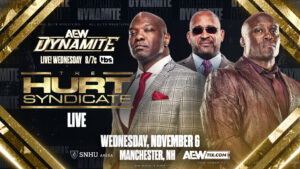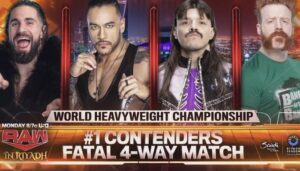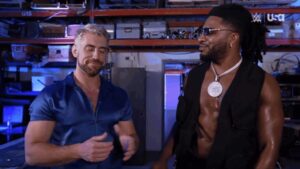Thirty years ago this month, on April 13, 1990, three of the world’s most powerful wrestling promotions, Japan’s All Japan Pro Wrestling (AJPW) and New Japan Pro Wrestling (NJPW) and US juggernaut the World Wrestling Federation (WWF), united together for the Wrestling Summit, that would combine the talents of all three companies rosters for one giant event of international proportions. Instead, it would end up a mostly forgotten spectacle that would ultimately lead to fractured alliances that would re-shape the wrestling landscape.

Through the end of the 1970s and much of the 1980s, Vince McMahon Jr. had managed to secure an alliance with NJPW for when they did tours of Japan. Meanwhile, AJPW had remained faithful to the National Wrestling Alliance (NWA). For two decades, they stood as the pillars of Japanese puroresu, battling for superiority like Coke vs Pepsi. But in 1984, a group of New Japan wrestlers, led by Akira Maeda, quit the promotion and started up the Universal Wrestling Federation (UWF). UWF lasted a year, with most returning to NJPW. But in 1988, most of the same group once again quit New Japan and restarted UWF, taking some top Young Lions like Minoru Suzuki and Masaharu Funaki, and bringing in gaijin like Ken Shamrock, Norman Smiley, and former WWF World Champion Bob Backlund. With their “shoot style” martial arts-based style, UWF got off to a hot start in their second run. On November 29, 1989, UWF held U-Cosmos at the Tokyo Dome, which became the fastest sell-out for pro wrestling at the Big Egg, 50,000 people, with no TV promotion. Suddenly New Japan and All Japan were taking more serious notice.

Eager to knock the new kids off the block quickly, New Japan founder Antonio Inoki booked a show at the Tokyo Dome for that February 10, determined to create a monstrous SuperShow to break UWF’s record. Inoki had big plans to feature the top four World Champions in pro wrestling, with IWGP Heavyweight Champion Vader, WWF World Heavyweight Champion Hulk Hogan, AWA World Heavyweight Champion Larry Zbyszko, and NWA World’s Heavyweight Champion Ric Flair, all competing on the same card. Hogan fell through and although originally slated to face The Great Muta, Flair would ultimately withdraw (reportedly due to pressure from Turner Broadcasting). Down both Hogan and Flair, Inoki reached out to arch-rivals AJPW, who agreed to join the SuperShow, called Super Fight in Tokyo. New Japan’s Masa Saito beat Zbyszko for the AWA World title, while Vader fought All Japan’s Stan Hansen to a double count-out in his iWGP title defense (most famous for being the match where Hansen gouged out Vader’s eye), and Super Fight packed 53,900 into the Tokyo Dome.

A few weeks prior to Super Fight, on January 27, 1990, WWF owner Vince McMahon showed up at an All Japan show at Kōrakuen Hall in Tokyo, where he met AJPW owner Shohei “Giant” Baba in the ring to announce that the WWF live event on April 13, 1990, would now be a united SuperShow featuring stars from WWF, AJPW, and NJPW calling the Wrestling Summit. Despite some New Japan talents like Keiji Muto working for WCW since 1989 as The Great Muta (and earlier with the NWA), WCW was not invited to the event.

The card for Wrestling Summit was as follows:
- Can-Am Express (Dan Kroffat & Doug Furnas) & Joe Malenko vs. Revolution (Samson Fuyuki, Tatsumi Kitahara & Toshiaki Kawada)
- Jushin ‘Thunder’ Liger vs. Akira Nogami
- Kenta Kobashi & Masanobu Fuchi vs. “Superfly” Jimmy Snuka & Tito Santana
- Bret “Hitman” Hart vs. Tiger Mask II (Mitsuharu Misawa)
- Greg “The Hammer” Valentine vs. The Great Kabuki
- Jake “The Snake” Roberts vs. Big Bossman
- IWGP Tag Team Championship: Masa Saito & Shinya Hashimoto (c) vs. Masahiro Chono & Riki Choshu
- Jumbo Tsuruta & Haku vs. Mr. Perfect & “The Model” Rick Martel
- “Macho Man” Randy Savage w/ Sensational Sherri vs. Genichiro Tenryu
- WWF World Heavyweight Championship: Ultimate Warrior (c) vs. “Million Dollar Man” Ted DiBiase
- Giant Baba & Andre the Giant vs. Demolition (Ax & Smash)
- Hulk Hogan vs. Stan Hansen

Hulk Hogan’s original opponent for the main event was Terry “Bam Bam” Gordy (as seen in the original poster up top), but once Hogan lost his WWF World Championship to WrestleMania VI thirteen days earlier, Gordy backed out last minute (some suspect he didn’t want to look weaker in a non-title match). Reportedly All Japan wanted former All Japan Triple Crown winner Genichiro Tenryu to face Hogan, but McMahon insisted his star face another American, so Stan Hansen became the replacement and Tenryu got a nice consolation prize in Randy Savage instead. Ultimate Warrior‘s World title defense against The Million Dollar Man was also his first defense since defeating Hogan less than two weeks before.
Yoshiaki Yatsu, the 2x Olympian wrestler and star with NJPW and AJPW, was originally supposed to be Jumbo Tsurata’s tag team partner, but an injury before the event led to Haku being a last-minute sub. Due to Nippon TV, the home for All Japan, controlling the broadcast rights, none of the matches featuring NJPW talent was aired, and the first two matches were live/dark matches only. Several matches featuring WWF talent have shown up on collections for some of the Superstars, but the full Wrestling Summit event is not available to watch on the WWE Network or NJPW World. Despite NJPW holding SuperFight only a few months prior, Wrestling Summit still managed to attract 43,700 people to the Tokyo Dome.

Shortly after Wrestling Summit, Genichiro Tenryu left All Japan to front a new promotion, Super World of Sports (SWS). SWS was founded by a top eyeglass company in Japan, Megane Super, who bank-rolled Tenryu to lure several stars from NJPW and AJPW to the promotion: Yatsu, Minoru Suzuki, George Takano (Cobra), The Great Kabuki, Hiromichi Fuyuki, Tatsumi “Koki” Kitahara, Naoki Sano, Hisakatsu Oya, and more were brought in to the rising promotion. By October, they had secured a working alliance with the WWF, that saw stars from Hulk Hogan to the British Bulldog working SWS shows in Japan, including several SuperShows at the Tokyo Dome. But with WWF now allying with SWS, New Japan ended its alliance with them, instead looking to other options. The event would also be the last time New Japan and All Japan would work together for a decade, possibly over New Japan’s matches being blacked out on the actual broadcast.
With their decade-plus alliance with the WWF now ended, New Japan looked to a former ally to reconcile. During parts of the 1970s, NJPW also worked with the NWA, but in 1990, the NWA had effectively been absorbed by Ted Turner’s World Championship Wrestling (WCW) and its accumulated territories of Mid Atlantic, Mid South, Championship Wrestling From Florida, Central States, and Sam Muchnik‘s St. Louis territory. New Japan entered into a cross-promotional alliance that would help kickstart both companies into the new decade. As New Japan was breaking grounds with its emerging IWGP Junior Heavyweight division, its influence on WCW’s breakout Cruiserweight Division is undeniable – several of those Junior Heavyweights, like Wild Pegasus (Chris Benoit) and Black Tiger (Eddie Guerrero), would find their US breaks in WCW. The opening match of the first WCW Monday Nitro was Brian Pillman vs. Jushin Thunder Liger, highlighting both company’s bold new directions. New Japan and WCW also held three SuperShows together, from 1991 through 1993 at the Tokyo Dome, with the 1992 edition kicking off the first-ever January 4 event that became Wrestle Kingdom in 2007. In 1995, NJPW and WCW would stage the two-day Collision in Korea to bring pro wrestling to North Korea. New Japan would remain allied with WCW until its purchase by Vince McMahon and WWE in 2001.
WWF’s gamble that the deep pockets of Megane Super would make SWS the top product in puroresu failed terribly. By 1992, the dire economy of Japan put everyone in a financial crunch and Megane Super’s interest in SWS waned to the point of non-existence. By the summer of 1992, the company had folded. But the desire of a new option other than NJPW or AJPW in Japan led SWS’ top stars to start new promotions: Yatsu formed Social Pro Wrestling Federation (SPWF, 1993-1997), Kendo Nagasaki‘s Network Of Wrestling (NOW, 1992-1994), and George & Shunji Takano’s Pro Wrestling Crusaders (PWC, 1993-1995). But the most influential promotion to emerge from the fall of SWS was Tenryu’s Wrestle and Romance (WAR) in 1992.
https://www.youtube.com/watch?v=D3HeU0iT6lo
WAR became a highly influential new promotion in Japan (it rebranded as Wrestle Association R (WAR) in 1995), who managed to maintain alliances with NJPW (Tenryu had signed with them in 1992 as well), Frontier Martial-arts Wrestling (FMW), and even the WWF (through Tenryu’s connection with SWS). They introduced the concept of pushing a junior heavyweight tag team division before even New Japan, with the International Junior Heavyweight Tag Team Championship in 1996 (the first IWGP Junior Tag Team Champions would be crowned in NJPW in 1998). WAR saw the likes of Chris Jericho, Rey Mysterio, Juventud Guerrera, Lance Storm, Ultimo Dragon, and Gedo & Jado go through its doors early, as well as future New Japan stars like a young Tomohiro Ishii. WAR remained a fixture on the Japanese wrestling landscape of the 1990s, before shutting down in 2000.
NJPW would never work with the WWE again after Wrestling Summit. Instead, New Japan created the IWGP Conception, an alliance that includes Ring of Honor (ROH) in the United States, Consejo Mundial de Lucha Libre (CMLL) in Mexico, and Revolution Pro (RevPro) in the United Kingdom. The WWE has seemingly attempted veiled attempts at restoring some honor between the company, with WWE Hall of Fame inductions for New Japan legends Antonio Inoki (2010), Tatsumi Fujinami (2015), and Jushin ‘Thunder’ Liger(2020), and in 2015, Liger competed in NXT at NXT TakeOver: Brooklyn against Tyler Breeze. But with the launch of New Japan of America (NJOA), New Japan seems confident in its ability to enter the US market without the need for WWE’s assistance.
WWE would also never work with All Japan again following the Wrestling Summit, and it would take a decade before they would at least get relations between AJPW and NJPW to the point of cross-promotion. It wouldn’t be until NJPW Do Judge!! on October 9, 2000, that the two would work again, packing in over 60,000 fans at the Tokyo Dome. In a shocking main event, IWGP Heavyweight Champion Kensuke Sasaki vacated his title after losing to 3x All Japan Triple Crown Winner Toshiaki Kawada in a non-title match. Since then, New Japan and All Japan have worked sporadically, including a 40th co-anniversary series in 2012.

Due to the various companies involved, the matches never truly survived and the Wrestling Summit, which was designed to bring the international wrestling community together, instead became a martyr for a new future. Largely forgotten, the business dealings leading up to and after the event would go on to shape a new direction for pro wrestling in the 1990s, whose impact in Japan and North America would forever be altered.






